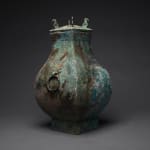Han Bronze Fang Hu, 206 BCE - 220 CE
Bronze
height 38.7 cm
height 15 1/4 in
height 15 1/4 in
H.857
Further images
The angular contours of this vessel distinguish it from other vessels used to hold liquids for ceremonial use. Its large voluminous shape with a protruding belly and tapered neck make...
The angular contours of this vessel distinguish it from other vessels used to hold liquids for ceremonial use. Its large voluminous shape with a protruding belly and tapered neck make it suitable for storage as well. As opposed to the common hu, this vessel comes equipped with a decorative lid mounted with highly stylized “s”-shaped images of animals, possibly of a snake or swan. This refined fang hu is essentially unadorned, save for two decorative Tao Tieh mask handles that have been attached to the swelling body. These stylized animals represent a type of dragon found in Chinese mythology. Their abstracted representation demonstrates, as well as the incised patterns, the influence of previous styles such as the Zhou Dynasty. Over the ages, the bronze has acquired a fabulous patina of green hues, adding both delightful colors and pleasing textures to this otherwise sparsely adorned vessel. The Han Dynasty is known as the cultural blossoming period in Chinese history. Common belief held that if the way of the Sages was restored, then social order and moral uprightness of men could be achieved. Bronze vessels served an important role in the world of rites and ritual as well as in the realm of men who longed for expensive bronze ware to demonstrate their power and prestige. Although this vessel would have served as a wine container in life, it was found discovered buried in a tomb. A symbol for the bountiful pleasures of life, for drinking and feasting, this fang hu would have represented the joys to be experienced in the afterlife and the feasts and celebrations yet to come. Today, this vessel is not only a gorgeous work of art, treasured for its history and rarity; but also a stunning reminder of the richness and luxury of the Han Dynasty, both in this world and the next.





